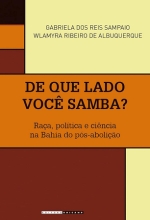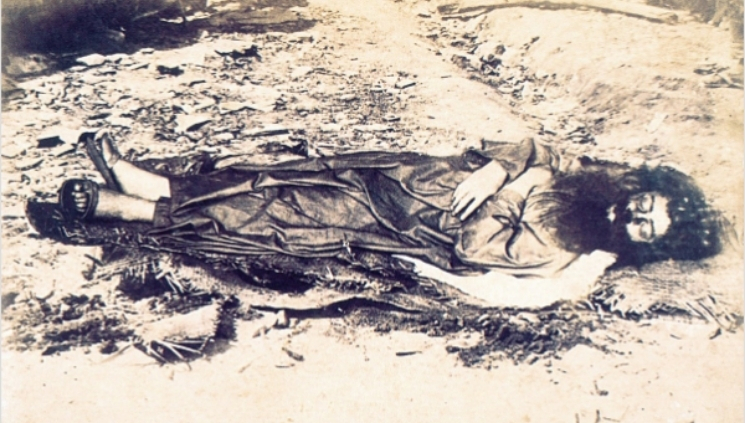Citizenship for whom? — Edvaldo Alves de Souza Neto’s (UFS) review of “De que lado você samba? raça, política e ciência na Bahia do pós-abolição”, by Gabriela dos Reis Sampaio e Wlamyra Ribeiro de Albuquerque

Abstract: De que lado você samba? raça, política e ciência na Bahia do pós-abolição,” by Gabriela Reis Sampaio and Wlamyra Ribeiro de Albuquerque, scrutinizes racial exclusion in Bahia following the 1888 abolition of slavery. It underscores the employment of scientific racism to negate citizenship rights to black and mixed-race individuals. Despite criticism for its unclear objectives, the study is acknowledged for its illumination of racial disparities.
Keywords: racism, scientism, and politics.
De que lado você samba? raça, política e ciência na Bahia do pós-abolição,” authored by historians Gabriela Reis Sampaio and Wlamyra Ribeiro de Albuquerque, endeavors to dissect the “disputes, tensions, and negotiations at the socio-racial frontiers of Salvador, with a particular focus on the period between 1888 and 1905—a time replete with crises, divisions, and reforms of varying magnitudes and depths within Brazilian society” (p. 17). Released by Editora Unicamp in 2021 in e-book format, the publication facilitates reader interaction with distributed audiovisual resources. The research incorporates official documents, memoirs, travel narratives, newspaper pieces, and contemporary scholarly writings, complemented by a plethora of images and phonograms.
 Gabriela Reis Sampaio and Wlamyra Ribeiro de Albuquerque, both PhDs and professors of History at the University of Campinas (Unicamp), contribute to undergraduate and graduate programs in the Department of History at the Federal University of Bahia (UFBA). As CNPq researchers, they have consistently explored Brazil’s 19th and early 20th centuries in their scholarly guidance. This book specifically addresses post-abolition contexts in Bahia, especially Salvador, examining the adversities encountered by the black community amidst the construction of socio-racial barriers by a white, literate elite affiliated with the Faculty of Medicine of Bahia. This elite aimed to preserve, within the nascent republican era, a hierarchical structure derived from slavery, subordinating a black majority to safeguard the privileges of a white minority. Organized into six chapters, besides the introduction and epilogue, the book spans 356 pages in the Kindle edition referenced here.
Gabriela Reis Sampaio and Wlamyra Ribeiro de Albuquerque, both PhDs and professors of History at the University of Campinas (Unicamp), contribute to undergraduate and graduate programs in the Department of History at the Federal University of Bahia (UFBA). As CNPq researchers, they have consistently explored Brazil’s 19th and early 20th centuries in their scholarly guidance. This book specifically addresses post-abolition contexts in Bahia, especially Salvador, examining the adversities encountered by the black community amidst the construction of socio-racial barriers by a white, literate elite affiliated with the Faculty of Medicine of Bahia. This elite aimed to preserve, within the nascent republican era, a hierarchical structure derived from slavery, subordinating a black majority to safeguard the privileges of a white minority. Organized into six chapters, besides the introduction and epilogue, the book spans 356 pages in the Kindle edition referenced here.
The inaugural chapter portrays the celebrations orchestrated around slavery’s abolition in Salvador, spotlighting those initiated by carnival clubs and those linked with the academic body of the Faculty of Medicine of Bahia. Herein, the participation of young doctors in the abolitionist movement is revealed, and post-abolition, their advocacy for the inferiority of the colored populace as they eschewed political dialogue with those emancipated from enslavement and their descendants, crafting a moralistic and civilizing rhetoric underpinned by scientific racism. These contentious and racialized demarcations, as described by the authors, thread through the subsequent pages of the study.
The second chapter delves into the contestation for public spaces, encircled by racialized dialogues and confrontations over the freedom and citizenship of the black populace “at the time of abolition” (p. 63). A pivotal moment is the reception of Silva Jardim, a notable Republican Party advocate who arrived at Salvador’s port, awaited by students from the Faculty of Medicine of Bahia. Nonetheless, he was met with hostility by monarchists, predominantly black, who eagerly anticipated Count D’Eu, the prince consort aboard the same ship with the mission of salvaging the empire. Through an analysis of the skirmishes between monarchists and republicans, the authors elucidate how republicans, men of science, sought to forge a narrative steeped in scientific racism to restrict the colored population’s right to political participation in the period’s debates, thereby curtailing their access to citizenship.
Subsequent chapters investigate the conflicts between republicans and monarchists. Despite the School of Medicine’s significant role in rallying Republican youth towards the abolitionist cause, its academics refrained from engaging in political discussions with people of color post-abolition. The republican national project, conceived within this institution and deeply influenced by scientific racism, overlooked measures to address the disparities bequeathed by the Empire, legitimizing the state’s repressive measures against African descendants’ expressions.
In the fourth chapter, the focus returns to the carnival. The transition from monarchy to republic, marking the end of slavery and the ascendancy of a project for complete white citizenship in a predominantly black city (p. 145), necessitated the “civilization” of Salvador. Consequently, a committee from the Faculty of Medicine was established to determine parade participation and club inclusion criteria. While health policies aimed to expunge black cultural references from public spaces during festive occasions, men of color, erstwhile abolitionist movement affiliates, championed divergent views on the rights and boundaries of black participation in the carnival. They argued for access to public education and full citizenship for those freed from bondage and their descendants as a means to ameliorate the dire circumstances faced by the newly liberated individuals and their progeny.
The fifth chapter addresses the conflicts over the control and prohibition of Candomblé practices, anchored in a case examined by Nina Rodrigues, who witnessed an “exuberant” ebó at a friend’s home. The authors trace the discourses and perceptions surrounding African-origin religions at the Republic’s dawn. While Rodrigues documented and frequented numerous Candomblés across Bahia’s capital, aiming to comprehend them through reductive racist theories, several newspapers lambasted these religious practices, prompting police intervention to uphold “good customs” and “civilization,” as perceived through the lens of European religiosity, notably Catholicism.
In the concluding chapter, by scrutinizing records left by intellectuals like Manoel Querino and primarily, Nina Rodrigues, the historians juxtapose Candomblé with the Catholic religion, examining how the latter assimilated aspects of the former in a “creolization of Catholicism” process. This reinterpretation of the European religion practiced by Africans and their descendants in Brazil alarmed the purportedly “civilized” white elite. The examination of gender dynamics within these civilizing and moralistic perspectives reveals a relegated social status for women compared to men. Additionally, the authors assess the political roles of religious leaders in the burgeoning republic, aiming to consolidate Candomblé traditions.
The epilogue reflects on the exhumation of Antônio Vicente Mendes Maciel’s (Antônio Conselheiro) remains, the Canudos revolt leader (1896–1897), under Nina Rodrigues’s keen anticipation. This coroner from Maranhão sought to validate racial theories blaming miscegenation for degeneration through measurements and weight analyses. Thus, “[Conselheiro’s] head served as evidence of [the Republic’s] triumph, as well as the ideal chance to confirm” the peril posed by “mestizo populations” (p. 254).

Although Nina Rodrigues determined that Conselheiro possessed a normal skull, thereby not degenerate but insane, this episode crucially reflects the racialization of mestizo bodies by Faculty of Medicine doctors. These professionals essentially became state extensions, furnishing mechanisms and justifying social and racial control forms applied to the impoverished and colored populace in “civilization’s” name.
In summary, the study unveils various facets of post-abolition Salvador, albeit occasionally exceeding the Bahian capital’s confines. For readers unfamiliar with Salvador and its environs, a map detailing these locales would enhance spatial understanding and navigation through the referenced sites.
The narrative’s coherence suffers from Sampaio and Albuquerque’s decision to omit a direct presentation of overarching goals in the introduction and specific objectives within individual chapters and the epilogue. This omission renders the reading somewhat disjointed and perplexing, particularly in segments that could benefit from enhanced contextualization of historical sources, images, and phonograms, as astutely noted by A. A. Romo (2022).
Nevertheless, the work compellingly demonstrates, through varied testimonies, how Bahia’s republic, under the influence of scientific racism, endeavored to restrict black and mixed-race populations’ citizenship to preserve a racial hierarchy inherited from the slavery era. Post-reading, it becomes apparent that citizenship was designed and implemented for the white elite, though the black population carved its path to political engagement and rights assertion.
Thus, the authors achieve their primary aim by documenting the conflicts and negotiations surrounding Bahia’s racial boundary in the post-abolition period. On one hand, “samba” involved Faculty of Medicine academics who, leveraging scientific racism theories, sought to maintain antiquated racial structures in the fledgling republican era, thereby subjugating and stereotyping non-whites through a moralistic and civilizing lens. On the other hand, the color population, with their rhythms and beliefs, endeavored to claim urban spaces, interpret their surroundings, and advocate for rights, asserting their legal equality in the aftermath of slavery. Consequently, the book is a valuable resource for post-abolition specialists, undergraduate students, and the general public interested in post-abolition developments in Brazil and the Afro-Brazilian population’s citizenship consolidation challenges.
References
ROMO, A. A. Laboratório para uma República racista: Bahia no pós-abolição. Afro-Ásia, Salvador, n. 65, p. 768–777, 2022. Disponível em: https://periodicos.ufba.br/index.php/afroasia/article/view/48608. Acesso em: 27 jun. 2023.
Summary of De que lado você samba? Raça, política e ciência na Bahia do pós-abolição
- Introdução
- 1. O carnaval do Treze de maio
- 2. Varreram o Silva Jardim
- 3. A República dos médicos
- 4. Navegadores e cientistas
- 5. Doutores e feiticeiros
- 6. Santo Gonocô e Pai Ojú
- Epílogo — “Quase pretos de tão pobres”
- Notas
- Créditos de imagens, fonogramas e vídeos.
- Fontes e bibliografia
- Sobre as autoras
Reviewer
 Edvaldo Alves de Souza Neto has a master’s degree in História and a degree in História from the Universidade Federal de Sergipe (UFS). He is the author, among other texts, of Saindo das Senzalas, mas não da História: libertos em Sergipe no pós-abolição (2017). He is a member of the Grupo de Estudo e Pesquisa Pós-abolição no Mundo Atlântico at the Universidade Federal de Sergipe. ID LATTES: http://lattes.cnpq.br/8893500007937852. ID ORCID: https://orcid.org/0000-0002-4070-7006. E-mail: edvaldo.asn@gmail.com.
Edvaldo Alves de Souza Neto has a master’s degree in História and a degree in História from the Universidade Federal de Sergipe (UFS). He is the author, among other texts, of Saindo das Senzalas, mas não da História: libertos em Sergipe no pós-abolição (2017). He is a member of the Grupo de Estudo e Pesquisa Pós-abolição no Mundo Atlântico at the Universidade Federal de Sergipe. ID LATTES: http://lattes.cnpq.br/8893500007937852. ID ORCID: https://orcid.org/0000-0002-4070-7006. E-mail: edvaldo.asn@gmail.com.
To cite this review
SAMPAIO, Gabriela dos Reis; ALBUQUERQUE, Wlamyra Ribeiro de. De que lado você samba? raça, política e ciência na Bahia do pós-abolição. Campinas: Editora Unicamp, 2021. 356p. Review by: SOUZA NETO, Edvaldo Alves de. itizenship for whom? Crítica Historiográfica. Natal, v.4, n.15, jan./feb., 2024. Available at <https://www.criticahistoriografica.com.br/en/citizenship-for-whom-edvaldo-alves-de-souza-netos-ufs-review-of-de-que-lado-voce-samba-raca-politica-e-ciencia-na-bahia-do-pos-abolicao-2/>.
© – Authors who publish in Historiographical Criticism agree to the distribution, remixing, adaptation and creation based on their texts, even for commercial purposes, as long as due credit for the original creations is guaranteed. (CC BY-SA).








